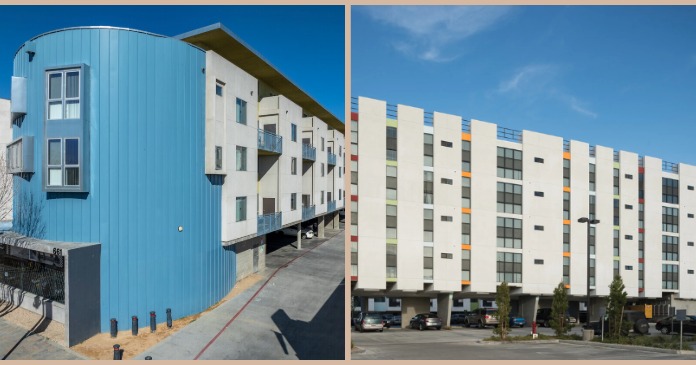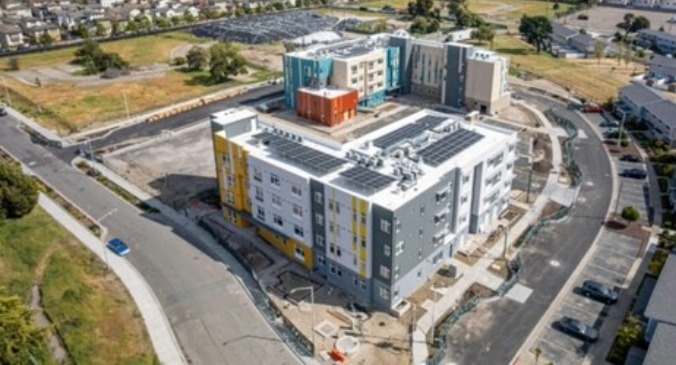Revisions to Fannie Mae’s housing forecast in April call for more multifamily starts across the entire forecast horizon than in last month’s forecast. Fannie Mae is now predicting 359,000 starts in 2025 with 390,000 starts in 2026.
By contrast, the forecast for single-family housing starts was revised lower from Q2 2025 through the end of 2026.
Lower growth and lower rates
Fannie Mae’s forecasters revised their predictions for GDP and employment growth in 2025 significantly lower this month while revising their prediction for inflation significantly higher. While, in the past, Fannie Mae’s forecasters would provide the reasoning behind the changes they made to their forecast, their recent forecasts have been presented without explanation. However, one would assume that the uncertainties introduced by President Trump’s tariff program as he attempts to reset the United States’ terms of trade with the rest of the world are the impetus for these revisions. Given that no one knows if the threatened tariffs will actually be imposed or if they are just a bargaining chip, the forecast must be viewed as being highly uncertain.
Despite the higher inflation forecast but perhaps because of the lower growth forecast, Fannie Mae’s forecasters predicted that the Federal Reserve will lower the Fed Funds rate more than they predicted last month. They now predict an additional quarter-point rate cut in Q4 2025 bringing the year-end rate to 3.9 percent. They expect the Fed Funds rate to fall to 3.1 percent by the end of 2026, a half-point lower than they predicted last month.
Despite the lower forecast for the Fed Funds rate, this month’s forecast for the 10-year Treasury rate was not significantly changed. The forecasters lowered their predicted interest rate in Q3 2025 by 0.1 percentage point to 4.2 percent. They raised their predicted 10-year Treasury rate in Q3 2026 by 0.1 percentage point to 4.4 percent. However, they still expect the rate to end 2025 at 4.3 percent and to end 2026 at 4.4 percent.
Multifamily starts forecast higher
The current forecast for multifamily housing starts is shown in the first chart, below, along with three other recent forecasts. Fannie Mae considers any building containing more than one dwelling unit to be “multifamily”, including both condominiums and rental housing units.
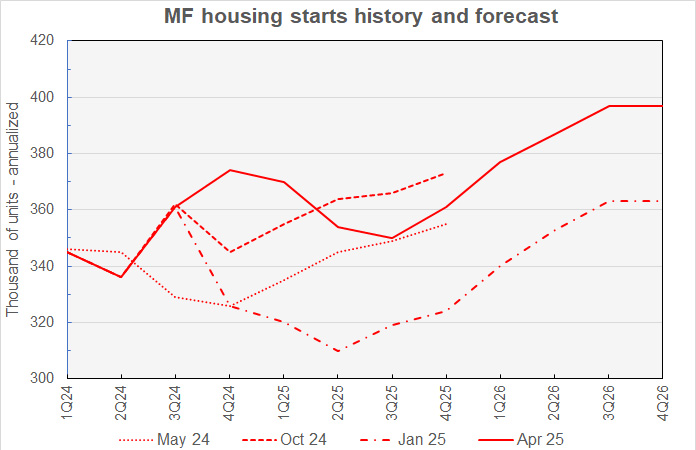
Revisions to Fannie Mae’s multifamily housing starts forecasts were all to the upside this month. Oddly, the largest revision made was to the forecast for Q1 2025, a quarter that has already closed. The starts “forecast” for that quarter was raised by 22,000 (annualized) units to 370,000 units. Other than that, the largest revisions made were for 13,000 and 14,000 additional annualized units in Q1 and Q2 2026 respectively.
The low point for multifamily starts is now seen as being in Q3 2025 with 350,000 annualized starts. The forecast calls for multifamily housing starts to rise from that point, ending with 397,000 annualized unit starts in Q3 and Q4 2026. This is up from 379,000 annualized starts for Q4 2026 predicted last month.
For reference, the most recent new residential construction report from the Census Bureau has multifamily starts running at a seasonally-adjusted annualized rate of 381,000 units in Q1 2025.
Looking at yearly forecasts, the predicted number of multifamily starts for 2025 was revised higher by 10,000 units to 359,000 units. The forecast for multifamily starts in 2026 was revised higher by 11,000 units to 390,000 units.
Single-family starts forecast lower
The current forecast for single-family housing starts is shown in the next chart, below, along with three other recent forecasts.
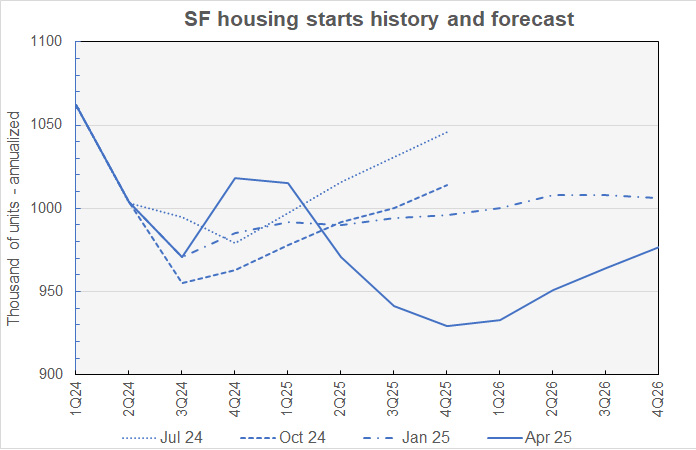
The single-family starts quarterly forecast was revised higher for the already closed Q1 2025. All other quarterly forecasts going forward were were revised lower. The largest revision was to the starts forecast for Q4 2025, which was revised lower by 65,000 annualized units.
The low point for single-family starts going forward is now predicted to be Q4 2025 at 929,000 annualized units. Starts are forecast to rise from that point. Single-family starts are predicted to reach an annualized rate of 977,000 in Q4 2026, down 21,000 units from the level predicted last month.
Looking at full-year predictions, Fannie Mae now expects 29,000 fewer single-family starts in 2025 than forecast last month at 964,000 units. Fannie Mae now expects 40,000 fewer single-family starts in 2026 than forecast last month at 956,000 units.
GDP growth for 2025 revised sharply lower
The next chart, below, shows Fannie Mae’s current forecast for Gross Domestic Product (GDP) growth, along with other recent forecasts.
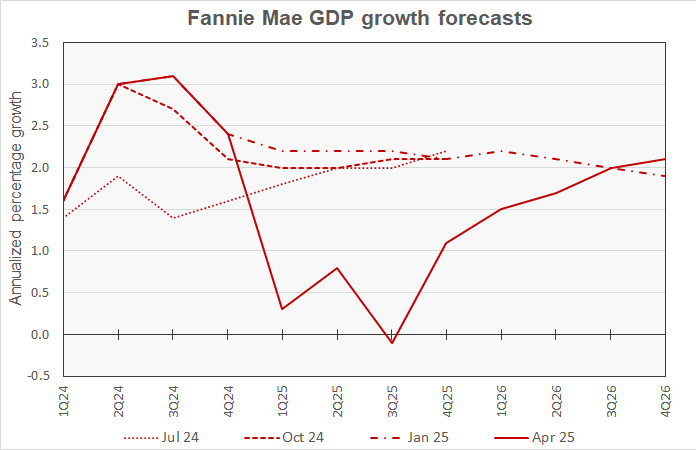
On April 30, the Bureau of Economic Analysis (BEA) released their advance estimate of Q1 2025 GDP, which came in at -0.3 percent. This estimate, which will be updated twice before it is considered final, was not available to Fannie Mae’s forecasters when they made their GDP growth estimates.
The current forecast sharply reduced the GDP growth predictions for 2025 with the largest revision being a 1.9 percentage point reduction in the GDP growth prediction for Q3 2025. This resulted in a predicted decline of 0.1 percent in GDP for that quarter. From that point, the economy is predicted to recover rapidly, ending 2026 with a Q4 GDP growth rate 0.1 percentage point higher than that predicted last month.
Fannie Mae’s forecasters now expect year-over-year GDP growth to be 0.5 percent in 2025, down 1.2 percentage points from the rate predicted last month. They expect 2.1 percent growth in 2026, down 0.2 percentage points from their last prediction.
PCE Inflation forecast higher again
The next chart, below, shows Fannie Mae’s current forecast for the chained personal consumption expenditures (PCE) inflation rate, along with three other recent forecasts.
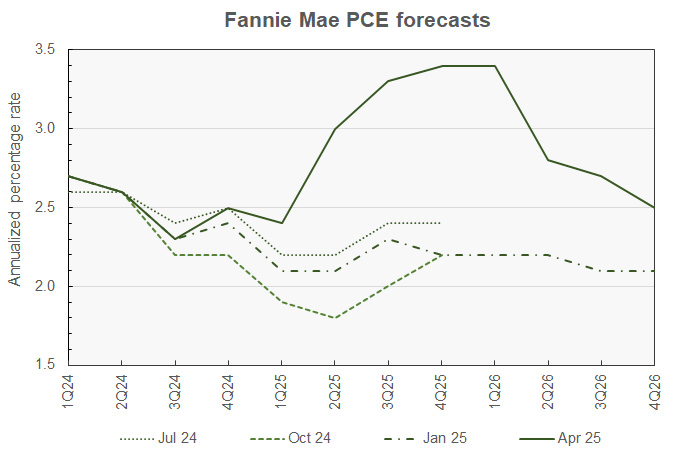
For the third consecutive forecast release, Fannie Mae’s forecasters raised their inflation forecasts for 2025 significantly. They again expect inflation to climb through the year, now peaking at 3.4 percent in both Q4 2025 and Q1 2026. The Q1 2026 rate is up by 0.7 percentages points from last month’s prediction while the Q2 and Q4 2025 rates are each up 0.5 percentage points.
Fannie Mae now expects year-over-year PCE inflation of 3.4 percent in 2025, falling to 2.5 percent in 2026.
Inflation induced by a jump in tariffs is different than other sources of inflation in that it is based on a one-time event. Unless tariffs continue to be raised, the inflation will not bleed over into the following years. Also, if the Trump-imposed tariffs result in new trade deals being negotiated and those deals reduce the tariffs again, it is possible that this process will put downward pressure on prices in future years. This does not seem to be considered in Fannie Mae’s forecasts.
Are job losses coming?
The next chart, below, shows Fannie Mae’s current forecast for employment growth, along with three earlier forecasts. Employment growth is our preferred employment metric since job gains, along with productivity gains, drive economic growth. By contrast, the unemployment rate depends on employment but also on the labor force participation rate. Either rising employment or falling labor force participation can drive the unemployment rate lower, but only the former would contribute to economic growth.
Note that the population estimates upon which the employment data is quoted was updated in January, so the figures from earlier forecasts may not be directly comparable to those from current forecasts.
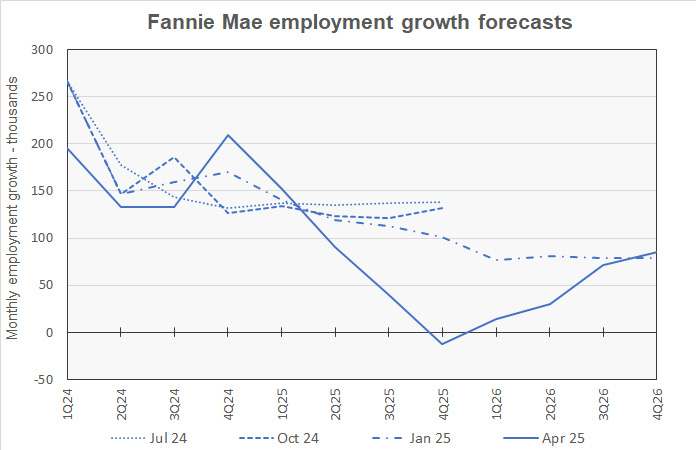
The forecasters revised their estimates for employment growth in Q1 2025 higher by 46,000 jobs per month to 152,000 jobs per month. However, they revised their predictions for employment growth through most of the rest of the forecast horizon lower, by up to 109,000 jobs per month in Q4 2025. They are now predicting monthly job losses averaging 12,000 jobs in that quarter. Employment is predicted to return to growth in Q1 2026 and, by Q4 2026, the forecasters are predicting a higher rate of employment growth than they predicted last month at 85,000 jobs per month.
For reference, the business survey in the April Employment Situation Report from the Bureau of Labor Statistics indicates that the economy added an average of 133,000 jobs per month in Q1 2025.
Employment growth in 2025 is now expected to be 800,000 jobs, down by 500,000 jobs from last month’s estimate. The employment growth forecast for 2026 calls for the economy to add 600,000 jobs, down by 400,000 jobs from.
The Fannie Mae April forecast can be found here. There are links on that page to the detailed forecasts and to the monthly commentary.




